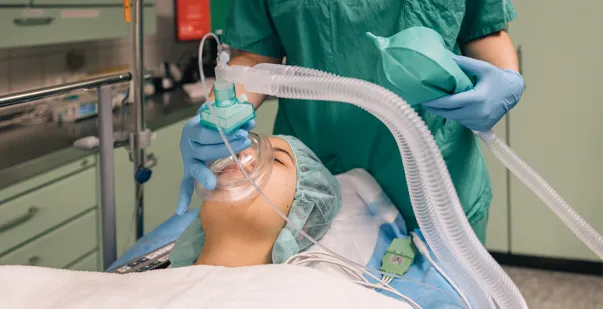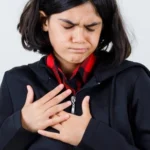Table of Contents:
- Introduction
- Causes of Respiratory Distress
- Assessment and Management of Respiratory Distress
- Transition from Respiratory Distress to Respiratory Failure
- Treatment of Respiratory Failure
- Prevention and Prognosis of Respiratory Illness
- Wrapping Up
The agony of a child who is struggling to breathe is one of the scariest things parents or caregivers witness. Indeed, respiratory distress and respiratory failure are alarming. However, you can turn this fear into action.
PALS training is a life-saving skill that every child caregiver should learn. It allows them to recognize and respond to life-threatening emergencies like respiratory distress.
In this comprehensive guide, we’ll cover everything you need to understand about respiratory distress and failure. We will understand about assessment and management of respiratory distress, PALS croup treatment, and how we can prevent this life-threatening situation.
Causes of Respiratory Distress
Respiratory distress is a state in which the body needs more oxygen. Its effects include rapid breathing, low oxygen levels in the blood, and difficulty breathing.
There are four major categories of respiratory distress/failure; namely, upper airway, lower airway, lung tissue disease, and central nervous system. The table below shows its common causes in the pediatric population.
| Upper airway | Lower airway | Lung tissue disease | Central nervous system |
| Croup (swelling) | Bronchiolitis | Pneumonia | Head Trauma |
| Retropharyngeal abscess | Asthma | Pneumonitis | Overdose |
| Anaphylaxis | – | Pulmonary Edema | – |
| Foreign Body |
Pediatric acute respiratory distress syndrome (ARDS) occurs when body fluids fill the lungs. It generally occurs due to an injury or infection. These body fluids prevent air from filling the lungs effectively, leading to a shortage of oxygen throughout the body.
There are direct and indirect causes of respiratory distress among children.
Direct
- Breathing harmful fumes or smoke
- Chest trauma
- Inhaling vomit (aspiration)
- Near drowning
- Pneumonia
Indirect
- Blood transfusions
- Injury that causes low blood pressure
- Pancreatitis (inflammation of the pancreas)
- Severe and widespread bacterial infection (sepsis)
Signs and Symptoms of Respiratory Distress
The signs and symptoms of acute respiratory distress among children include:
- Fast breathing,
- Difficulty in breathing,
- Cough (generally pink/white frothy sputum),
- Fatigue,
- Fever,
- Increased heartbeat.
Read More: Cardiac disease in the young: Recognizing and Understanding Early Signs.
Assessment and Management of Respiratory Distress
Assessment of respiratory distress among pediatric patients often has a multi-faceted approach. While there’s no specific test, it may involve physical examination like evaluation of respiratory rate. In advanced condition, it may require a chest x-ray and blood test. Once the underlying cause is determined, various treatment options may be explored.
Here are the ways to diagnose respiratory distress or failure through the PALS respiratory distress algorithm
- Lab Tests: It measures the oxygen level using blood from an artery. PALS treatment for croup requires a lab test, checking for lung infection.
- Heart Tests: Since the symptoms of respiratory distress resemble heart problems, doctors may recommend heart tests like:
- Electrocardiogram (ECG): ECG tracks down the electrical activity in your heart.
- Echocardiogram: It shows how blood travels through the heart valves and chambers
- Chest X-ray: A chest X-ray shows which part of the lungs and how much part of it has fluid in them. It confirms if the patient’s heart has become bigger. Additionally, a CT scan combines X-ray images to create cross-sectional glimpses of internal organs like the heart and lungs.
Treatment of Respiratory Distress
The upper and lower respiratory airways must be considered to determine the level of oxygen. Hence, the degree of respiratory distress influences treatment. For instance, the initial treatment for moderate asthma PALS requires bronchodilator inhalers. However, severe asthma needs endotracheal intubation.
| Upper Airway (includes the nose, nasal cavity, and pharynx) | |
| Causes | Treatment |
| Croup | Corticosteroids
Oxygen (Heliox) Nebulizer (epinephrine) Intubate Tracheostomy |
| Foreign Body | Corticosteroids
Oxygen (Heliox) Nebulizer (epinephrine) Intubate Tracheostomy |
| Anaphylaxis | Epinephrine IM
Nebulizer Diphenhydramine |
| Lower Airway (includes the larynx, lungs, bronchial tree, and trachea) | |
| Causes | Treatment |
| Bronchiolitis | Suctioning
Nebulizers |
| Asthma | Oxygen (Heliox)
Nebulizers (albuterol and ipratropium bromide) Corticosteroids Magnesium sulfate Epinephrine SQ Support breathing |
Transition from Respiratory Distress to Respiratory Failure
Both respiratory distress and respiratory failure demand are medical emergencies. Approx 20% of overall deaths of children aged <5 years worldwide are caused by respiratory infections. Most of these infections take the form of respiratory failure. Therefore, it is important to take immediate action and give prompt treatment to children.
To avoid the fatal implications of respiratory failure, caretakers/parents should observe the following symptoms in children.
Respiratory failure either depends on inadequate oxygen or excessive CO2 in the blood. If a child is hypoxemic (inadequate oxygen), the symptoms may include;
- Shortness of breath
- Cyanosis (a bluish coloration on the skin around the mouth, eyes, and nails)
- Faster heart rate
- Coughing or wheezing
- Severe headache
- Pulmonary hypertension
If a child is hypercapnic (excessive CO2), the symptoms include;
- Rapid breathing
- Confusion or disorientation
- Flushed skin
- Muscle twitches
- Elevated blood pressure
- Headache
- Lethargy and drowsiness
Other severe symptoms include:
- Irregular heartbeat (Arrhythmia)
- Seizure
- Fainting
- Panic attack
Thus, regular monitoring and reassessment of respiratory status is essential to identify the signs of respiratory failure. Healthcare providers must closely monitor the following to prevent its progression;
- Vital signs and symptoms
- Oxygen saturation levels
- Blood pressure levels
It is a crucial decision for medical professionals to consider a higher level of care. In some cases, the victim’s health can deteriorate despite aggressive treatment. Hence, these professionals may consider the following factors to make such a crucial decision.
- Oxygenation status
- Ventilatory requirements
- Overall clinical status
Read More: Blood Pressure & Heart Rate: Relationship & Differences
Treatment of Respiratory Failure
When respiratory failure is diagnosed, appropriate treatment is essential to improve the chances of recovery. The management of respiratory illnesses like croup treatment PALS includes oxygen therapy and mechanical ventilation.
Just like other respiratory illnesses, croup is a very common respiratory infection among children. Several viruses cause it like:
- Parainfluenza virus
- Respiratory syncytial virus (RSV)
- The flu (influenza virus)
- Adenovirus
- Enteroviruses
It is mostly observed in children aged between 3 months and 5 years. The most common symptoms include;
- Runny nose
- Stuffy nose
- A slight cough turns into a seal’s bark
- Losing voice (laryngitis)
- Fever
- A “squeaking” or whistling sound when breathing in (stridor)
If a child is not breathing well, they should immediately be taken to the hospital. However, it is easier to manage milder cases at home. While it is hard to tell if the young patient needs to visit the hospital due to changes in illness, following medicines can help ease symptoms.
- Inhaled medicines: These medicines are used in pediatric patients who face difficulty in breathing. Inhaled treatments reduce the whistling sound (stridor), making it easier for them to breathe.
- Steroids: Doctors generally give an injectable steroid to young patients if they are unable to take steroids orally. These steroids thereby prevent the illness from getting worse.
- Other medicines: Medical professionals in a child’s respiratory healthcare may prescribe other medicines if the child has croup due to allergies or reflux. They may also recommend acetaminophen or ibuprofen for a fever or discomfort. It should be noted that antibiotics are of no use if the illness is caused by a virus.
For a milder case, treatment for croup PALS includes;
- Make the pediatric patient drink plenty of water and other fluids. Let them take a substantial amount of rest.
- Prevent yourself from smoking around in the home. Smoke can worsen the couch and the health of the child.
- Keep the child’s head raised. If the child is older, prop him up in bed with extra pillows. Avoid using pillows for babies less than 12 months.
- Stay around so that you can rescue the child if they face trouble breathing.
- Stay calm. If the child observes that you are anxious, they will panic more, and their health may further deteriorate.
- Comfort the child patient by singing their favorite bedtime song
Prevention and Prognosis of Respiratory Illness
Respiratory Tract Infection (RTI) remains the prominent cause of child mortality worldwide. Several factors influence the rise of respiratory illness in children. As it becomes more hazardous, it is crucial to monitor and prevent respiratory distress trends.
Here are the symptoms and prevention of common respiratory illnesses that every parent/caretaker should know to protect the health of children.
-
Asthma
- Symptoms: According to the PALS asthma algorithm, the symptoms of asthma include;
- Coughing
- Wheezing
- Chest tightness
- Shortness of breath
- Prevention: The preventive measures include;
- Identifying and avoiding triggers
- Managing allergies
- Maintaining clean environment
-
Bronchiolitis
- Symptoms: The symptoms of bronchiolitis include;
- Cough
- Wheezing
- Difficulty in breathing
- Prevention: The preventive measures include;
- Washing hands frequently
- Avoiding exposure to sick people
- Promoting breastfeeding
-
Pneumonia
- Symptoms: The symptoms of pneumonia include;
- Fever
- Cough
- Chest pain
- Rapid breathing
- Prevention: The preventive measures of pneumonia include;
- Vaccination
- Good hygiene practice
- Adequate nutrition
Here are the other ways to prevent respiratory distress/damage in children.
- Vaccination
Children can avoid respiratory distress by receiving recommended vaccines like those for influenza and pneumonia. Healthcare providers should take care of proper vaccination routines to prevent respiratory infections.
- Hygiene
Ensure proper hygiene by letting children wash their hands regularly, especially during cold and flu seasons.
- Healthy lifestyle
Children promote a healthy lifestyle by having a balanced diet, adequate hydration, and regular physical activity.
- Environmental Awareness
Children should minimize exposure to air pollutants, and parents must maintain clean indoor air quality through proper ventilation and cleanliness.
To respond to respiratory illness among children effectively, make sure to get proper PALS certification and recertification from a certified organization. Practice regularly and stay up to date on the latest guidelines. It will help you act readily and responsibly.
Wrapping Up
Knowing how to respond to PALS respiratory distress and respiratory failure techniques is an essential skill for parents or caregivers. Whether the child is suffering from mild respiratory distress or a fatal breathing condition, the right knowledge of the PALS respiratory algorithm is key to responding effectively.
With proper treatment and lifestyle modification, young patients can avoid respiratory failure. By seeking prompt medical attention, children or infants can stay protected from its long-term implications. Thus, parents must stay updated with the latest guidelines on PALS respiratory illnesses to ensure the overall well-being of their children.
Don’t wait for the emergency to occur before acquiring these vital skills. Find a PALS respiratory distress class near you and get trained sooner. By learning PALS treatment, you will equip yourself with techniques to save your child’s life against respiratory illness.






